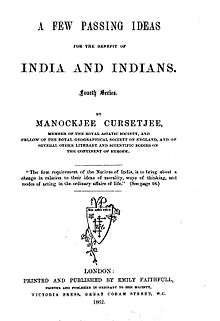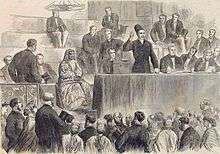Manockjee Cursetjee
Manockjee Cursetjee (also Manakji Kharshedji Shroff)[1] (1808–1887)[2] was a Parsi businessman and judge from Bombay, remembered as a reformer and proponent of female education.

Life
Cursetjee was the son of Cursetjee Manockjee Shroff,[3] and had an English education, under a Mr. Mackay at Joliffe's school, near St. Thomas's Church.[4] In the 1830s, he knew John Wilson, whom he met socially in 1829.[5] He obtained a government post in the Bombay Presidency, and became a member of the Royal Asiatic Society.[6][7] In 1843 he became a Fellow of the Royal Geographical Society.[8]

Cursetjee was a noted Anglophile, and came into conflict with the local Parsi Panchayat. He began to criticise them, in the Bombay Times, in 1844–5.[3][9] He visited the United Kingdom three times. On one visit to London, he met Arthur Wellesley, 2nd Duke of Wellington, whose father Arthur Wellesley had been entertained by his own father in Bombay at a garden party.[5]
In 1859 Cursetjee started the first English school for Indian girls. Initially it was in his house, "Villa Byculla", with an English governess and his daughters as staff. The initiative gained the support of Kharshedji Nasarwanji Cama and John Elliot Drinkwater Bethune. In 1863, with a land grant and a donation from Cursetjee, the Alexandra Native Girls' English Institution set up in its own premises.[10]

In 1863, also, Cursetjee joined the Faculty of Law of Bombay University.[11] In 1866 he addressed the Social Science Congress in Sheffield, England, on education in India.[12]
Legacy
The school Cursetjee founded, the Alexandra Girls' English Institution named after Alexandra of Denmark (originally the Alexandra Native Girls' Institution),[13] still exists.[14]
Cursetjee set up a public monument, now known as the "Khada Parsi", to commemorate his father.[15][16] Its location is now between two flyovers in Byculla.[17]
Family
His second son Cursetjee Manockjee studied at Oxford University and Lincoln's Inn.[18] He was the first Indian to be admitted as an Oxford undergraduate.[19] Another son, Jehangir Manockjee Cursetjee, matriculated at Trinity College, Cambridge in 1867.[20]
Notes
- ↑ Dosabhai Framji Karaka (1 June 2004). History of the Parsis Including Their Manners, Customs, Religion and Present Position. Kessinger Publishing. p. 262. ISBN 978-1-4179-2168-3. Retrieved 22 June 2013.
- ↑ Jesse S. Palsetia (1 January 2001). The Parsis of India: Preservation of Identity in Bombay City. BRILL. p. 74. ISBN 978-90-04-12114-0. Retrieved 23 June 2013.
- 1 2 Jesse S. Palsetia (1 January 2001). The Parsis of India: Preservation of Identity in Bombay City. BRILL. p. 150. ISBN 978-90-04-12114-0. Retrieved 22 June 2013.
- ↑ James Douglas, Glimpses of old Bombay and western India, with other papers (1900), p. 21; archive.org.
- 1 2 James Douglas, Bombay and Western India, a series of stray papers vol. 2 (1893) p. 131–2; archive.org.
- ↑ George Smith (7 June 2012). Life of John Wilson, D.D. F.R.S.: For Fifty Years Philanthropist and Scholar in the East. Cambridge University Press. p. 332. ISBN 978-1-108-05045-6. Retrieved 23 June 2013.
- ↑ Journal of the Royal Asiatic Society of Great Britain and Ireland. Royal Asiatic Society of Great Britain & Ireland. 1837. p. 292 note 2. Retrieved 23 June 2013.
- ↑ Royal Geographical Society (1854). The Journal of the Royal Geographical Society: JRGS. Murray. p. xx. Retrieved 23 June 2013.
- ↑ Shefali Chandra (2 May 2012). The Sexual Life of English: Languages of Caste and Desire in Colonial India. Duke University Press. p. 37. ISBN 978-0-8223-5227-3. Retrieved 23 June 2013.
- ↑ Jesse S. Palsetia (1 January 2001). The Parsis of India: Preservation of Identity in Bombay City. BRILL. pp. 151–. ISBN 978-90-04-12114-0. Retrieved 23 June 2013.
- ↑ The Bombay University Calendar for the Year 1869–70. 1869. p. 130. Retrieved 23 June 2013.
- ↑ Journal of Social Science. Chapman and Hall. 1866. p. 23. Retrieved 23 June 2013.
- ↑ Emily Faithfull (1868). Victoria Magazine. Emily Faithfull. p. 187. Retrieved 22 June 2013.
- ↑ Alexandra Girl's English Institution, History.
- ↑ Marpakwar, Chaitanya MarpakwarChaitanya; Mirror, Mumbai (19 June 2014). "Iconic Khada Parsi statue restored". Mumbai Mirror. Retrieved 15 December 2016.
- ↑ The Hindu, Restoring the ruptured heritage.
- ↑ dinodiamumbaiphotos.com, Khada Parsi Statue at Byculla; Mumbai; India.
- ↑ []
- ↑ William Simpson (2002). Diary of a Journey to Abyssinia, 1868: With the Expedition Under Sir Robert Napier, K.C.S.I.: the Diary and Observations of William Simpson of the Illustrated London News. Tsehai Publishers. pp. 166 note 1–5. ISBN 978-0-9723172-1-4. Retrieved 22 June 2013.
- ↑ "Jehanghir Manockjee (CRSY867JM)". A Cambridge Alumni Database. University of Cambridge.